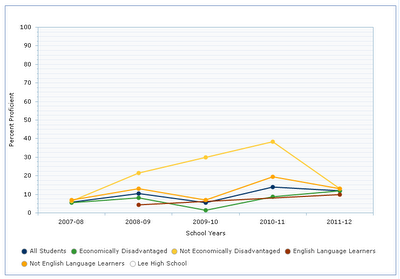Excuse me while I adjust my eyes to this blinding flash of the obvious.
Buried in today's media frenzy over the Supreme Court decision on Obama-Care, the State of Michigan released the annual test results for all 11th graders administered this past spring. Michigan's assessment includes a conglomeration of commercial and home-grown tests carved up and pasted together to give the overall results. Those assessments include:
- ACT Plus Writing (administered on day one of testing)
- ACT WorkKeys assessments in Reading for Information, Locating Information, and Applied Mathematics (day two)
- Michigan assessments in social studies and science (day three)
According to a release by
The Education Trust-Midwest, a relentless watchdog group that periodically gets caught playing loose with the facts to support their pre-disposed positions, the results, which come after the State Board of Education changed the cut scores to raise the bar,
illustrate growing achievement gaps. The following was sent to me by email:
Among key findings from today’s 2012 MME results:
• Over the past five years, MME results show that the black-white achievement gap has grown in every subject (math, reading, science, writing) but social studies. Black 2012 proficiency rates are a shocking 35 percent lower than whites in reading, writing and social studies; gaps similar to those found in the NAEP.
• Even some MME gains are hardly worth celebrating. In 2008, for instance, 3 percent of African American high school juniors in Michigan scored proficient in math. This year, 6 percent score proficient. Math proficiency rates for low-income students rose from 8 to 13 percent over this period.
• Moreover, the gap between poor and more affluent Michigan high school students has grown in every subject but reading since 2008, according to MME data. (emphasis added)
• Only 1-in-4 Michigan students are proficient in the MME in 11th-grade science. Among blacks, the rate is 4 percent. For Latino and low-income students, the rates are 13 percent and 12 percent, respectively.
“We have a lot to learn from other states where students’ growth is far outpacing ours here in Michigan, including among minority and low-income students,” Arellano said. “And we must for our children’s sake.” (emphasis added)
One of the key findings that "we" can learn from this is until Michigan addresses the equity gap in school funding for districts with high percentages of students living in poverty, English language deficiencies, and transiency, the gaps between poor and affluent districts are likely to continue even if all districts slowly raise the overall achievement levels in the coming years. Addressing achievement gaps that are embedded in significant social and economic disparities requires more time for learning, smaller class sizes, more training for teachers and administrators, along with upgraded facilities, new equipment and expanded technology comparable with affluent districts. These cost money and require greater flexibility in the use of compensatory funding currently coming into the district from state and federal sources. Most of our districts, however, have experienced a steady erosion in state funding over the past decade and an extreme reduction just in the past two budget cycles under Governor Rick Snyder and his legislative accomplices.
In the interest of full disclosure, I am providing graphs of our district high school's assessment results illustrating a five-year trend. The previous years' scores have been modified to reflect what they would have been under the state's revised cut scores.
Lee High School MME Reading Proficiency
This first graph provides a comparison between all students, those that are economically disadvantaged (greeen line - about 80% of the entire group), not-economically disadvantaged, English language learners (red line - about 35% of the entire group) and non-English language learners. You can see the gaps for yourself (note: no ELL students scored proficient in 2011-12).
Lee High School MME Math Proficiency
The math scores in this second chart were lower altogether but you can still see the gaps over time. In particular, those students non-economically disadvantaged tended to score higher until this year which reflects the significant growth in the past year alone in percentage of our kids who are living in low-income and poverty households.
I encourage the folks at Ed-Trust-Midwest to read my recent post,
New Study Confirms Inequity of Michigan's School Funding System, as well as the references and related posts I cite within. While it is a solid fact that affluency in school districts correlates directly with higher achievement levels, our staff is still committed to doing the best we can possibly do to mitigate the obstacles faced by our kids and get them to a high level of college and career readiness by the end of high school. We also know, however, that the odds are not in our favor given the volumes of data already produced by studies I cite in my previous posts.
I'm certainly glad Ed Trust-Midwest sees the need for addressing the growing gaps but wish that they would come down from their fairyland idea of how public education should be funded to realize that a critical part of the equation will be providing an equitable start for kids being served in poor communities. Then maybe they can use their resources to convince our policymakers in Lansing and Washington. At the bottom of the email they sent me today is the following quote: "...to provide honest, reliable information to our state’s families and policymakers."
Ok, so start providing it.





